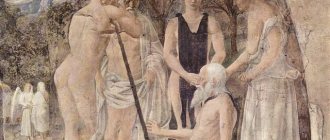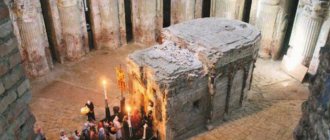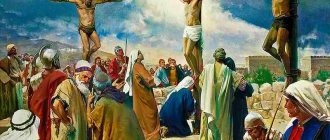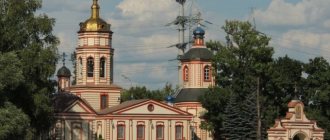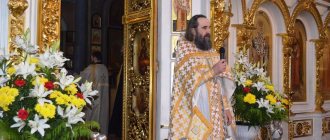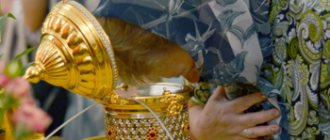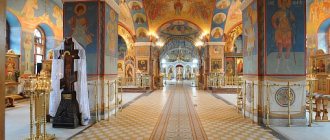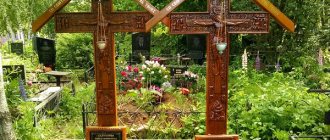The origin (wear and tear) of the honorable trees of the Life-giving Cross of the Lord , the Honey Savior and the beginning of the Dormition Fast - these are the Orthodox events celebrated on August 14 . On the same date, the “celebration of the All-Merciful Savior and the Most Holy Theotokos” is celebrated in memory of the victory won by Andrei Bogolyubsky over the Volga Bulgars in 1164. The noble prince took on his campaign the miraculous icon of the Vladimir Mother of God and the Honorable Cross of Christ. Before the battle, he fervently prayed to them, asking for protection and patronage. Therefore, the holiday was established in honor of this historical episode.
history of the holiday
Processions of the cross with the Life-giving Cross of the Lord were held through the streets of Constantinople.
August in Constantinople was one of the most difficult months of the year. Due to the influx of a huge number of traders and the heat, various diseases began to rage here, including epidemics and pestilences. Since even among the educated and comprehensively developed Greeks the level of medicine was far from modern, they took the lives of many people, sparing neither the poor nor the nobility. In this regard, in the 9th century, a decision was made for the Orthodox clergy to walk through the streets and roads of the city with the Honest Tree of the Cross (the same one to which Christ was nailed during the hours of execution) to consecrate various places so that the Lord would grant healing from ailments.
The Life-Giving Cross of the Lord was kept in the royal treasury. They took it out from there on the eve of the procession and placed it at the holy meal of the Great Church.
The procession of the cross through the streets was held daily until the Dormition of the Blessed Virgin Mary, as were litias throughout the city. At the end, the Cross was offered to the people for worship.
The Russian name for the holiday “ origin ” is not a completely accurate translation of the Greek word, which means a solemn ceremony, a religious procession. Therefore, the word “ wear and tear ” was added to the title.
The holiday was established in Constantinople in the 9th century, initially only as a local holiday. In the XII-XIV centuries it established itself in all Orthodox churches. It appeared in Rus' with the spread of the Jerusalem Charter at the end of the 14th century.
Carrying of the Honest Trees of the Life-Giving Cross of the Lord
The Feast of the Removal of the Honest Trees of the Life-Giving Cross of the Lord is celebrated on August 14 (New Art.)
See also: Carrying out the Honest Trees of the Life-Giving Cross of the Lord (honey Savior)
In the Greek book of hours of 1897, the origin of this holiday is explained as follows: “Due to illnesses that very often occurred in August, from ancient times the custom of wearing the Honest Tree of the Cross on the roads and streets was established in Constantinople. consecration of places and aversion to disease. The day before (July 31), having worn it out of the royal treasury, it was placed at the holy meal of the Great Church (in honor of Hagia Sophia - the Wisdom of God). From this day onwards until the Dormition of the Most Holy Theotokos, performing litias throughout the city, they then offered it to the people for worship. This is the origin of the Holy Cross.”
In the Russian Church, this celebration was combined with the commemoration of the Baptism of Rus' on August 1, 988. In the “Tale of the Effective Rites of the Holy Conciliar and Apostolic Great Church of the Assumption,” compiled in 1627 at the behest of the Patriarch of Moscow and All Rus' Philaret, the following explanation of the holiday on August 1 is given: “And on the day of the Holy Cross there is a process of consecration for the sake of water and enlightenment for the sake of human, in all cities and towns."
The news of the day of the Baptism of Rus' was preserved in chronographs of the 16th century: “The Great Prince Vladimir of Kiev and all Rus' was baptized on August 1.”
According to the rite now accepted in the Russian Church, the minor consecration of water on August 1 is performed before or after the liturgy. Together with the consecration of water, the consecration of honey is performed.
* * *
The holiday of the carrying of the Holy Cross was established on the first day of August in Greece by Patriarch Luke of Constantinople[1] under Tsar Manuel[2], and in Russia - by Metropolitan Constantine of Kiev[3] and Nestor, Bishop of Rostov[4], under Grand Duke Andrei Yuryevich[5 ]. The reason for its establishment was the following. Tsar Manuel and Prince Andrew, who were in peace and brotherly love among themselves, happened to go to war on the same day: the first from Constantinople against the Saracens, and the second from Rostov against the Bulgarians. (The Grand Duke lived at that time in Rostov: the pagans who lived on the lower reaches of the Volga were called Bulgarians, hence they got their name). The Lord God granted them complete victory over their enemies: the Greek king defeated the Saracens[7], and Prince Andrei Bogolyubsky defeated the Bulgarians and subdued them, turning them into his tributaries. – When Andrei went to war, he had the custom of taking with him an icon of the Most Holy Theotokos holding in her arms the Eternal Child, our Lord Jesus Christ, and an image of the Holy Cross of Christ, which was carried among the army by two priests. Just before the performance, he offered fervent tearful prayers to Christ and the Mother of God and partook of the Divine Mysteries of Christ. He armed himself with this invincible weapon more than with swords and spears, and he relied on the help of the Most High more than on the courage and strength of his army, knowing well the saying of David: “He does not look at the strength of the horse, nor does He favor the [speed] of human feet, - The Lord delights in those who fear Him, in those who trust in His mercy” (Ps. 146:10-11). The prince also encouraged his soldiers to pray both by the example of his own reverent prayers and by direct command, and everyone, falling on their knees, prayed with tears before the icon of the Most Pure Mother of God and the Honorable Cross of Christ. The Grand Duke, looking at the icon, said this in his prayer:
- Oh, Lady, who gave birth to Christ our God! Everyone who trusts in You will not perish, and I, Your servant, by the mercy of God, have in You a wall and a covering and the Cross of Your Son as a two-edged weapon against enemies. Pray to the Savior of the world, Whom you hold in Your arms, that the power of the cross may be like fire, consuming enemies who want to fight with us, and may Your omnipotent intercession help us overcome them.
After fervent prayer, everyone kissed the holy icon and the Holy Cross and fearlessly went against their enemies: the Lord helped them with the power of the cross and the Most Pure Mother of God helped them, interceding for them before God. Constantly adhering to this custom before each battle, the Grand Duke did not change it before the battle against the Bulgarians: he went out, having, like Tsar Constantine [8] in ancient times, the Cross of the Lord in front of his troops. Having entered the field after the battle with the Bulgarians, the Russian army put the latter to flight and, pursuing them, captured five cities; among them was the city of Bryakhimov on the Kama River. When they returned to their camp after the battle with the infidels, they saw that from the icon of the Mother of God with the Child Christ emanating bright rays, like fiery ones, illuminating the entire army; it was on the first day of August. The wondrous sight aroused the spirit of courage and hope in the Grand Duke even more, and he again turned his regiments in pursuit of the Bulgarians; he burned most of their cities, placing tribute on the survivors, and devastated the entire land; After this victory, the Grand Duke returned home in triumph. - The Greek king Manuel, who went out with his army against the Saracens, on the same day also saw a similar miracle - the emanation from the icon of the Most Pure Mother of God with the Savior, which was located along with the Honorable Cross among the army, overshadowing the entire regiment, and on that day he defeated the Saracens .
The king and the prince reported, giving glory to God, special messages to each other about the victories won with God's help and about the wonderful radiance emanating from the icon of the Savior. After consulting with the elder bishops, as a sign of gratitude to Christ the Savior and His Most Pure Mother, they established a holiday on the first day of August. In remembrance of the power of the cross, armed with which they defeated their enemies, they ordered the priest to wear the Holy Cross from the altar and place it in the middle of the church for Christians to worship and kiss it and to glorify the Lord Jesus Christ crucified on the cross. In addition, the bishops ordered the consecration of water to be performed on this day, which is why the holiday received its name - the carrying of the Honorable Cross, because the Honorable Cross is solemnly carried out along with other holy icons to rivers, wells and springs. - We celebrate, brothers, giving praise and thanks to the omnipotent God and our Savior Jesus Christ and His Most Pure Mother, the Lady Theotokos, reverently honoring the Honest Cross of Christ; but we celebrate with reverence, pleasing God, remaining in peace and love among ourselves, doing good deeds and moving away, remembering the fear of God, from sins: so that, having pleased our Creator and Master, we will be worthy of eternal celebration with all the saints after the day when the sign appears The Son of Man in heaven (Matthew 24:30), - the Honest Cross of Christ, preceding the coming of the Judge of the living and the dead, coming with much power and glory, and will illuminate all the righteous with bright and joyful rays. After the judgment is completed, he will come before all the saints, leading them into the Kingdom of Heaven, and all the saints will be blissful, rejoicing for endless ages; to them, through the prayers of our Most Pure Lady Theotokos, may our all-merciful Savior Christ count us sinners[9]. Amen.
Notes
[1] Luke Chrysoverg - Patriarch of Constantinople 1156–1169.
[2] Manuel Komnenos - Greek emperor 1143-1180.
[3] Constantine II, Metropolitan of Kiev, arrived in Kyiv from Greece in 1167; mentioned in the chronicle as early as 1169.
[4] Nestor, the sixth bishop of the Rostov diocese, is mentioned in the chronicle in 1149; in 1156 Nestor, slandered before the metropolitan by his family, was subject to prohibition; in 1157 he justified himself before the metropolitan, but in the same year, due to disputes about fasting on Wednesday and Friday, he was expelled from the pulpit by Andrei Bogolyubsky.
[5] St. rights. Andrei Bogolyubsky - the son of Grand Duke Yuri Vladimirovich and grandson of the glorious Vladimir Monomakh - was probably born in 1111. He was killed on June 30, 1175.
[6] Saracens are Muslims.
[7] There are no clear indications for the holiday of the All-Merciful Savior and the Most Pure Mother of God on the occasion of the victory over the Saracens of Emperor Manuel either in Greek historians or in Greek liturgical books. But in the history of Emperor Manuel, who waged many wars with different peoples, there are cases that should have aroused the king to special thanksgiving to God for the successful end of the war and deliverance from dangers. Here, the cruel war of King Manuel with the Turkish Sultan or the Saracens attracts attention. The king himself commanded the army, repeatedly exposing himself to extreme dangers. True, the victory went to the enemy, but the very salvation of the king was truly a miracle of God’s mercy. This was in September, but the campaign, of course, began earlier in August. After this war, the Greeks had two successful battles with the Saracens, and one of them was led by the king himself. These events, combined with news from Russia about God's help in the war against the Bulgarians, could have disposed Tsar Manuel to establish a common Christian holiday for the Savior, which had already begun in Constantinople with the blessing of water on August 1. But services to the Savior have not yet been found in Greek monuments of hagiology.
[8] Saint Constantine Equal to the Apostles - his memory is May 21.
[9] Standing on strictly defined historical ground, it should be noted that on the first of August the Orthodox Church celebrates two celebrations, different in origin: 1) the origin of the Honorable and Life-Giving Cross of the Lord and 2) the celebration of the All-Merciful Savior and the Most Holy Theotokos. In Greek Book of Hours, ed. 1897, this is how the origin of the first holiday is explained: “Due to illnesses that occurred very often in August, from ancient times the custom was established in Constantinople to wear the Venerable Tree of the Cross on roads and streets to consecrate places and to ward off illnesses. The day before (July 31), having worn it out of the royal treasury, it was placed at the holy meal of the great church (i.e. St. Sophia). From this day onwards until the Dormition of the Mother of God, holding litias throughout the city, they then offered it to the people for worship. This is the pre-origin (prodos) of the Holy Cross.” On August 14, the Cross returned to the royal chambers again. “This custom, in conjunction with another custom of Constantinople - to consecrate water in the court church of Constantinople on the first day of each month (except for January, when the consecration takes place on the 6th, and September, when it took place on the 14th) and served as the basis for the holiday in honor of St. and the life-giving Cross and the solemn consecration of water at the springs, which takes place on August 1.” Already in the 9th century there was this custom of carrying the Honest Tree from the royal chambers to the church of St. Sofia before August 1; the canon for the forefeast of the Cross on July 31, written for the present occasion (the canon begins with the words: the divine cross before the coming) is attributed to George, bishop. Amastridsky, who lived in the 8th century and was twice in Constantinople. In the Ritual of Emperor Constantine the Porphyrogenitus (912-959) there are detailed rules for when to remove the Cross from the chamber before August 1, depending on what day of the week this date falls on. In Russia, until the end of the 14th and beginning of the 15th centuries, when the Studite Charter reigned, neither on July 31 nor on August 1 was there any service to the Cross, which appears in the 14th-15th centuries. with the introduction of the Jerusalem Charter. The celebration of the All-Merciful Savior and the Most Holy Theotokos was established in Greece and Russia around 1168 in memory of the signs from the honest icons of the Savior and the Mother of God during the battles of the Greek king Manuel (1143-1180 with the Saracens) and the Russian prince Andrei Bogolyubsky with the Bulgarians in 1164.
The meaning of the holiday
The Sacrifice of the Savior on the Cross is a Sacrifice that transformed the instrument of death into the life-giving, victorious Tree of the Cross of the Lord
. The carrying of the Honorable Trees for every Orthodox person is not only a rite of worship of the life-giving Cross and a manifestation of reverence, but also a reason to confess one’s weakness before the greatness of this world, in which man is without God. help is like a speck of dust in a hurricane. On this day we remember the One by whose power the instrument of execution became the tree of life for the believer.
The beginning of the Assumption Fast is also timed to coincide with this day . This two-week and strict fast prepares us for the celebration of the Dormition of the Most Pure Lady Theotokos on August 28. Her life was full of hardships and hardships, she was destined to endure the torment of a mother who saw the torment of the crucified Son, and not only the Son, but the eternal God, suffering innocently with his sinless human nature for the sins of the whole world. These sufferings at Golgotha were the main sorrow of the Most Pure Lady in her earthly life. And the memories of this event again lead us to the reverent contemplation of the incomprehensible mystery of the redemptive Sacrifice of the Savior on the Cross - the Sacrifice that transformed the instrument of death into the life-giving, victorious Tree of the Cross of the Lord.
And today we turn to the Life-giving Cross of the Lord for the healing of soul and body.
Saving image
In Rus', the holiday began to be celebrated only 500 years after its establishment on the territory of the Byzantine Empire. In Russian chronicles, the reason for its occurrence was explained as follows: religious processions are important for enlightening the people and for the consecration of water.
Also on this day, they remember the victory of the Russian army over the Volga Bulgars before the battle. The commander prayed in front of the icon of the Mother of God holding the baby Jesus in her arms. During the battle, priests were present among the soldiers, who carried the image in the middle of the army. At the same time, the ruler of Constantinople also waged war against his enemies and won. The two kings were familiar with each other and knew about the military successes of each.
It must be said that both rulers not only prayed fervently themselves, but also showed by their example how the entire army should act. When both armies returned to their camps, all the soldiers saw that a wonderful glow was emanating from the image of the Most Pure Virgin Mary. The rulers informed each other about this, as well as the bishops of their states, and together they came to the conclusion that a holiday should be established in honor of this event on the first day of August.
Features of the Worship Service
Divine service for the Origin (wearing out) of the venerable trees of the Life-giving Cross of the Lord.
Features of the divine service are similar to the Week of the Worship of the Cross (3rd week of Lent) and the Feast of the Exaltation of the Holy Cross (September 14).
In the modern liturgical practice of the Russian Orthodox Church, Vespers is performed the night before, before which the Cross is transferred from the altar to the throne according to the rite established for the Week of the Worship of the Cross.
The minor consecration of water and honey is performed before or after the liturgy.
The accepted color of liturgical vestments for the holiday is violet (dark red).
- Troparion of the Holy Cross (Tone 1)
Save, Lord, Your people and bless Your inheritance, granting victories over the opposition and preserving Your life through Your Cross.
- Kontakion of the Holy Cross (Tone 4)
Ascend to the Cross by will, grant to Your namesake new residence Your bounty, O Christ God, make us glad with Your power, giving us victories for adversaries, benefit to those who have Your weapons This is an invincible victory for the world.
Holiday in Byzantium
The establishment of this holiday is also connected with that circumstance. In medieval Constantinople, numerous epidemics of terrible diseases occurred every year at the end of summer. The doctors of that time did not know how to cope with the scourge, and therefore they could only hope for the mercy of the Lord God.
Prayers were offered to the Creator during processions of the cross, which marched along the main streets of all Orthodox cities, singing the glory of Jesus Christ, and praying to the Lord for mercy and to grant the people salvation from all diseases.
Folk traditions and customs
On August 14, the Honey Savior is celebrated, the main dish of which was pancakes with honey and poppy seeds.
The Feast of the Origin (wearing down) of the honorable trees of the Life-giving Cross of the Lord was popularly called simply - Honey Savior . True, there were many other names - Poppy Spas, First Spas, Wet Spas, Spas on the Water. The Assumption Fast was affectionately called Spasovki by the people. Peasants in Rus' believed that these “two weeks were ‘cut off’ by God from Lent.”
What was customary to do on Honey Spas, according to Russian traditions and customs:
- attend worship services;
- bless water;
- bless the honey of the new harvest (make a wish while eating the first spoon of honey);
- consecrate bouquets of cornflowers and marigolds, dry them and store them at home as amulets;
- dig and clean wells (therefore Wet Spas);
- bathe the cattle for the last time;
- bake honey gingerbreads, pancakes with poppy seeds and honey, makans and machniki (lenten pies, rolls, buns, gingerbreads with poppy seeds and honey);
- brew mead;
- sow winter rye;
- prepare threshing floors and barns for the new harvest of bread, arable land for winter crops;
- in the evenings, dance in circles outside the outskirts, sprinkling each other’s heads with poppy seeds (hence the Poppy Spas).
Beekeepers had a whole ritual of consecrating honey on this day. In the morning they made the sign of the cross at the hives and chose among them the richest honey supply. They “broke out” the honeycombs from it and, setting aside a part, carried it to the church. After mass, the priest blessed the “new product” and blessed the honey brought in the honeycombs, and the clerk collected the “priest’s share.” Part of the blessed honey was immediately handed over to the beggars, congratulating the beekeepers on the Honey Savior. Then the holiday continued in the apiaries, where crowds of children and teenagers gathered.
What was strictly forbidden to do on this day according to Russian traditions:
- argue;
- swear;
- use obscenities;
- be in a bad mood;
- wish harm on other people.
Signs for August 14:
- Rain on Maccabee - there are few fires.
- If the raspberries are ripe in the forest and their berries are large, then it’s time to sow winter crops. If the berries are medium in size or small, then sowing should be postponed to a later period.
- If the roses have faded by this day, then the cold will soon come.
- If it’s a rainy day, you shouldn’t go out into the field to work.
- If the weather is windy, the winter will be snowy and frosty.
- What is the weather like on Honey Savior, will it be on the Assumption of the Blessed Virgin Mary (August 28).
Proverbs and sayings about the Honey Savior:
- For the first time, the Savior and the beggar will try the honey.
- On the first day of the Savior, bless the wells, bathe the horses in the river, pinch the peas, prepare the threshing floor, and plow for the winter.
- First Spas is the first sowing.
- To look up to Petrov, to fence up to Ilyin, to sow to Savior.
- The First Savior has everything in stock - rain, sun, and wind.
- The crane is flying away to Spas.
- On the First Savior, holy the wells, holy the bread wreaths.
- In the First Savior, any woman’s sin is forgiven.
- After the First Savior they do not enter the river.
August 14 is an important date for every believer. On this day, an Orthodox minor holiday is celebrated “with glorification” - the Origin (wearing down) of the honorable trees of the Life-giving Cross of the Lord . It would be a sin not to celebrate the First August Savior - Honey , to bless the honey. And also begin to prepare for the Dormition of the Most Holy Theotokos by dedicating a two-week Dormition Fast .
Baptism of Rus'
Therefore, it is easy to trace the connection of this event with the day of the Baptism of Rus', when Prince Vladimir converted several thousand of the Kyiv people to Christianity at once. There is a legend that Vladimir the Red Sun, realizing the inconsistency of the pagan religion that existed in Rus', decided to accept a new faith, and to choose it, he sent his ambassadors to some countries where the main religions were professed so that they would conclude that in each is the main thing. The most convincing was the story of the servants who visited Byzantium and spoke about the religion that was accepted in this state.
Nowadays, Prince Vladimir the Red Sun is glorified by the Russian Orthodox Church as an Equal-to-the-Apostles, that is, the person whose deeds were similar in significance to the deeds of the disciples of Christ, who spread Christian teaching throughout the world.
